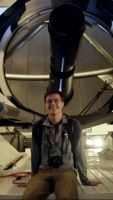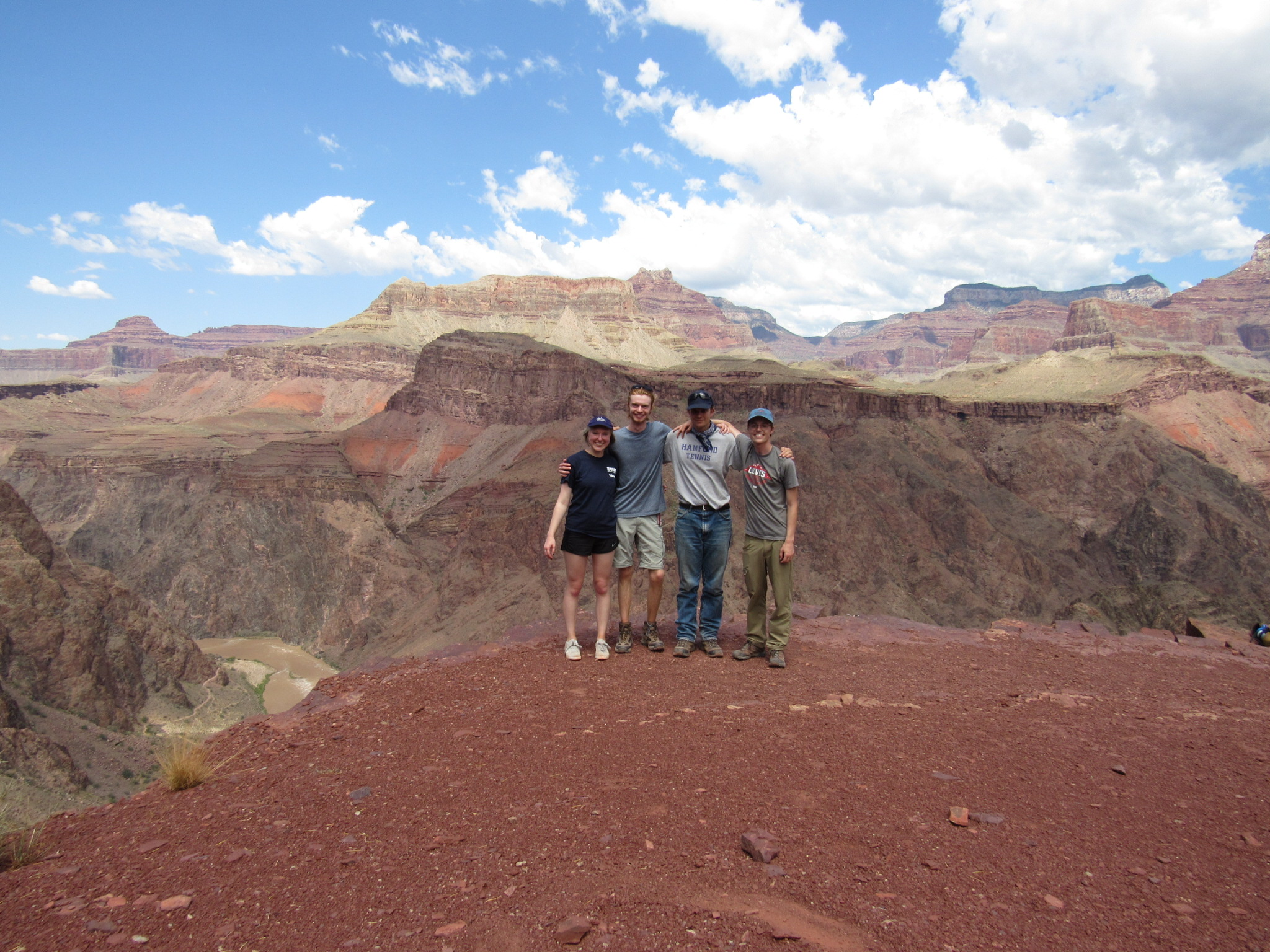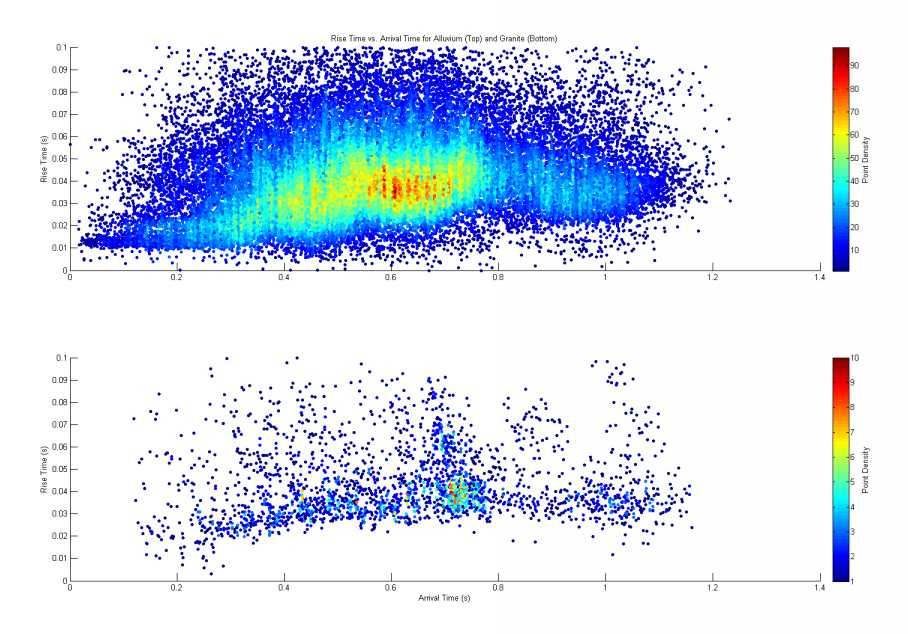James Atterholt

James Atterholt is a student at Indiana University currently completing his research at Los Alamos National Laboratory under Dr(s). Ting Chen and Cathy Snelson.
Over the period of one month, vertical and three-component seismic sensors recorded a large, underground, chemical explosion, hammer shots and ambient noise as part of the Source Physics Experiment (SPE). The ultimate goal of SPE is to produce a robust model which characterizes low yield nuclear tests to help discern these tests from other seismic activity. I will be working on creating an energy attenuation model using data from a portion of phase I (sources in hard rock geology) of the experiment. As of now, the method will be to use MATLAB to identify and measure variations in amplitude and frequency shifts recorded by the array during the experiment. I will then use these measurements to perform inversions which will yield a 2D (and possibly 3D) attenuation structure of the events. My work will then be combined with that of others working on the SPE to update and refine predictive models produced prior to data collection. The integration of predictive modeling and experimental data collection is what makes SPE unique from other experiments with a similar purpose.
Final Thoughts
August 22nd, 2017
This is a tad late. I'm writing this in Bloomington, having finished my internship last week. It's funny that Theresa quoted Hermann Hesse in her blog, because I read his work The Glass Bead Game this summer. I also happened to live near Knecht street in Los Alamos, Knecht being the title character of the novel. That's two too many coincidences for me not to quote Hesse myself: "Each of us is merely one human being, merely an experiment, a way station. But each of us should be on the way toward perfection, should be striving to reach the center, not the periphery." I suppose my internship did two things for me: it gave me the confidence to know that I could and reminded me of how much I need to learn to approach the center. These are two things that I don't think I knew I needed at the start of the summer, but I'm glad I learned them. I'm so grateful to have been a part of the IRIS program and to my mentor, who taught me so much throughout the summer. I can't wait to join my fellow geoscientists at AGU in December.
Week 6 or 7: Fortran Gets Old Quickly (but the grand canyon exists so it’s ok)
July 28th, 2017
So I've spent the last couple weeks debugging in Fortran. I must say, I will never take Matlab for granted again. I finally found all the bugs and can move on with my life (Hallelujah). Now I get to play around with parameters for my inversion problem. Probably the thing I've found to be most different from my life as an undergrad here is that progress is more difficult to come by. I've worked on a deadline before, but I've never had the feeling that when I was working I was making no progress. I put in a good 40 odd hours last week debugging and felt like I had gotten nowhere. When I think about the fruits of my labor, I like there to be fruit, and it can be discouraging when there's none. BUT, I've come to understand that it's a process, and even after 40 hours of your code bugging out in the same place, you've still gotten 40 hours worth of information about your problem that you didn't have before. It reminds me of that cliche about Edison and the lightbulb. This time it's Jimmy and the code.
Also, I got to spend a good long weekend at the Grand Canyon with Liam, Claire and Jonah. It really gave me some energy (figurative energy... I was literally exhausted). That helped me get back on my feet so very much. It's a good idea to take a break debugging and go to the most amazing place in the world with some good friends. That may not always be an option in the future, but it was just what I needed. Also, I wish I could take a picture of my workplace but Los Alamos doesn't allow pictures on lab property. You may have to settle for this picture of us at the canyon. Cheers!

Week 5: Progress Report
July 12th, 2017
Coming out of week 5 I really only have preliminary and relatively unreliable results. Fortunately, these results are interesting and make future work look promising. I have attached a scatter plot of the rise time (in our case the time between the first break and the following intercept) versus the arrival time for the signals from the hammer shots recorded by the array.  I have split this into two plots, one using signals from instruments place in alluvium and one using signals from instruments placed in granite. The slope of these points multiplied by a constant gives us an approximate value of the inverse of the quality factor (Q), a common parameter used to measure attenuation. We're getting reasonable Q values based on our slope which is encouraging, and what's perhaps more exciting is that we're getting much higher Q values (meaning lower attenuation) for signals recorded in granite than signals recorded in alluvium. I have attached another image of the relative positions of the stations of the array with the average differences between the expected rise times and the actual rise times based on offsets from the hammer shots.
I have split this into two plots, one using signals from instruments place in alluvium and one using signals from instruments placed in granite. The slope of these points multiplied by a constant gives us an approximate value of the inverse of the quality factor (Q), a common parameter used to measure attenuation. We're getting reasonable Q values based on our slope which is encouraging, and what's perhaps more exciting is that we're getting much higher Q values (meaning lower attenuation) for signals recorded in granite than signals recorded in alluvium. I have attached another image of the relative positions of the stations of the array with the average differences between the expected rise times and the actual rise times based on offsets from the hammer shots.  This image shows that we will likely see a variation in attenuative properties based on the variations in local geology throughout the array. I should be starting a more detailed model this week using Fortran (uh oh), and I can't wait to see more refined results from a more reliable approach! (LA-UR#17-25618)
This image shows that we will likely see a variation in attenuative properties based on the variations in local geology throughout the array. I should be starting a more detailed model this week using Fortran (uh oh), and I can't wait to see more refined results from a more reliable approach! (LA-UR#17-25618)
Week 4: El Santuario de Chimayo
July 5th, 2017
So week 4 passed by some time ago but it was a pretty fantastic week. I ended up going to Bandolier National Monument for the first time and a little old church in a town called Chimayo with a pretty amazing backstory. This was a great weekend and it definitely helped me gain some appreciation for where I am. As far as my project is concerned, it's chugging along pretty smoothly. My main obstacle has actually be Matlab licensing issues, which is unfortunate, but I think it's safe to say that I've been converted to the Matlab faith. This is pretty encouraging cause I'm well on my way to achieving one of my overarching goals for the summer. I'm getting into a rhythm now, and I'm starting to gush over everything New Mexico, especially the chiles.
Week 3: Elevators
June 26th, 2017
I finished my elevator speech today and practiced a little bit. I didn't think it was too bad, but I did have to take a step back and remind myself what was most important about my project and what people would need to know to get the gist. My speech will definitely be useful around the lab. Up until now, whenever anyone has asked me what I was working on I've always kind of struggled my way through a weak explanation. It definitely will feel a bit strange at first, it doesn't feel natural yet and I feel like I'm reciting a speech (which I kind of am). I probably won't use it in regular conversation, only at conferences, but it's super nice to have something I can draw from at the front of my mind in case I need it.
Week 2: The Data
June 19th, 2017
So I've been working with active source data stored in SEG Y. It was all cleaned up before I even looked at it. This has been pretty nice because it has allowed me to get down and dirty right off the bat and begin writing code to analyze it. I was a little nervous starting out, because everything I've been doing has been foreign to me. I initially had to learn to import data from various sources to MATLAB, but I think I've gotten the hang of that. Turns out MATLAB is super intuitive and it's been nice using software that's actually friendly to me.
The thing that had me most concerned on the rubric was the part about learning to read scientific literature effectively. I've always had trouble staying focused reading scientific papers and before this internship I had barely gotten through any papers and actually absorbed what was in them. I've learned that I can do it, I just need to be in a quiet room, wide awake and dead focused. It's good to know that I'm capable of reading these things, because you can't become an expert in a field if you don't know what the experts in that field are doing. You need scientific papers for this purpose.
Week 1: Getting Acclimated (Literally)
June 10th, 2017
The first week is under my belt now and I'm starting to feel at home. The air is thin, and the first week was hectic, but I'm falling for Los Alamos more and more every day. Now that I know the specifics of what I'll be doing, I feel I can make a proper list of goals for the summer. I'll be using a lot of MATLAB, so by the end of the summer I want to be a good enough MATLABBER (*one who uses MATLAB) so that when I encounter research problems in the future, I'll know how to attack them with that language. I also would at some point like to become comfortable with using inversion to solve geophysical problems by trying it first hand with my specific research problem. And I would like to do an exceptional job on my project, so that my work will help the larger project succeed in its goals. Outside of my work, I would like to become comfortable living somewhere that is not Indiana (this is my first time living anywhere else) and make meaningful connections with my mentor and other students and employees around the lab, who are all working on marvellous and interesting projects.


